|
|
![]()
FOREST HEALTH - SOFTWOOD LEAF DISEASES
Leaves hold a great amount of nutrients, sugars, and other food resources that attract a wide range of pathogens. Despite the structural and physiological defenses of a needle, pathogens frequently invade needles. Symptoms generally include browning, discoloration, small growths, and needle drop. Of course, these are symptoms similar to many insect infestations and nutrient stresses as well. Close examination of an affected needle (several samples are better) will usually show a lack of insect presence. Eliminating insects, then a pathogen may be the next likely cause. Wilting and browning needles often result from a disease of the tree's vascular system (trunk/branches), unseen under the bark. White pine blister rust is especially stem disease common. Several of the common vascular diseases are mentioned here, but properly belong in the stem and branch disease section. Also winter injury can cause browing, usually in June. Red text indicates an exotic pest.
| Needlecasts & Rusts
White Pine Blister Rust Witches Brooms |
For Christmas tree pests, refer to MSU Bulletin E-2676 "Christmas Tree Pest Manual", 143 pages. |
| Needlecasts and rusts (several genera): browning needles of various shades can indicate needlecast disease, usually not fatal, can render Christmas trees unsaleable, growing site can be dignostically important, browning pattern important (top down, inside-out, etc.) | |
| Hosts: all conifers, often species or genus specific diseases - Scots pine (brownspot, Cyclaneusma, others), spruces or firs (Rhizosphaera, Chrysomyxa), red pine (Coleosporium, Sphaeropsis, Sirococcus), cedar (Phomopsis), white pine (w.pine blister rust), balsam fir (Lirula) | |
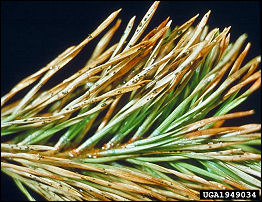 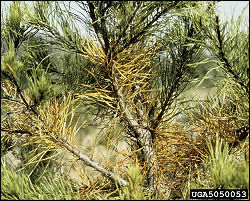 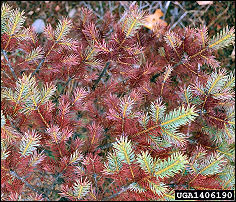 [Brownspot, Cyclaneusma, Rhizosphaera] |
|
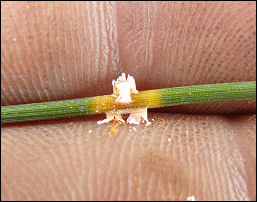 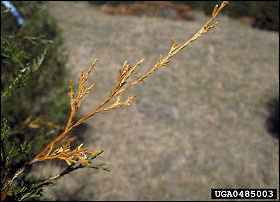 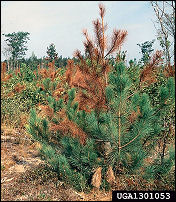 [Coleosporium, Phomopsis, Sphaeropsis] |
|
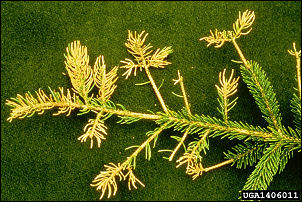 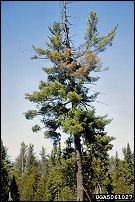 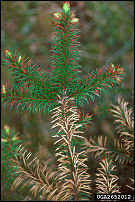 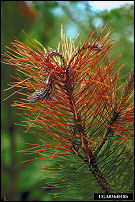 [Chrysomyxa, Cronartium ribicola, Lirula, Sirococcus] |
|
Witch's Brooms (many organisms): these clumpy concentrations of needles can be caused by a number of organisms, hormonal imbalances involved, occurs in hardwoods as well |
|
| Hosts: all conifers | |
 Witch's broom on red pine Witch's broom on red pine |
|
Image Citations
Brownspot Needlecast - Darroll D. Skilling, USDA Forest Service, Bugwood.org
Cyclaneusma Needlecast - Joseph O'Brien, USDA Forest Service, Bugwood.org
Rhizosphaera Needlecast - USDA Forest Service - North Central Research Station Archive, USDA Forest Service, Bugwood.org
Phomopsis Blight - David J. Moorhead, University of Georgia, Bugwood.org
Sirococcus Blight - Joseph O'Brien, USDA Forest Service, Bugwood.org
Chrysomyxa Rust - USDA Forest Service - North Central Research Station Archive, USDA Forest Service, Bugwood.org
White Pine Blister Rust - Joseph O'Brien, USDA Forest Service, Bugwood.org
Lirula Needlecast - Paul E. Hennon, USDA Forest Service, Bugwood.org
Sirococcus Blight - Robert L. Anderson, USDA Forest Service, Bugwood.org
All others - Bill Cook, Michigan State University Extension
Click HERE
to return to the U.P. Tree ID home page.
Click HERE to return to the Forest Health home page.
This site created and maintained by Bill Cook, MSU Extension Forester for the Upper Peninsula of Michigan. Editing and modification is ongoing. Submit suggestions, questions, and corrections to cookwi@msu.edu or call 906-786-1575.